- Home
- The Spring Garden
- Spring Perennials M-Z
Spring Perennials M - Z
More spring perennials to choose from for color and fragrance from lush peonies, colorful poppies, charming primroses and much more!
Our list of favorites continues here . . .
Meconopsis betonicifolia, Himalayan blue poppy, Zones 3-9. Would that I could grow the gorgeous Himalayan blue poppy, but I know that I lack the conditions it wants in my Georgia garden. I can’t give it the cool summers it requires, it would just languish and die, so I will just have to be jealous of gardeners in Alaska and other parts of the west and Northeast where they can grow them successfully. As I read in The Art of Gardening about Chanticleer in Wayne, PA, even they have to resort to buying plants from Alaska, and then treat them as annuals if they want to have them. But I was very happy to enjoy them on a recent trip to England at Hidcote Manor in late May and they were almost surreal in their delicate sky blue. Anyone who can provide shade, regular moisture, good rich soil and cool temperatures should give them a try, for I understand that they are easily grown from seed.
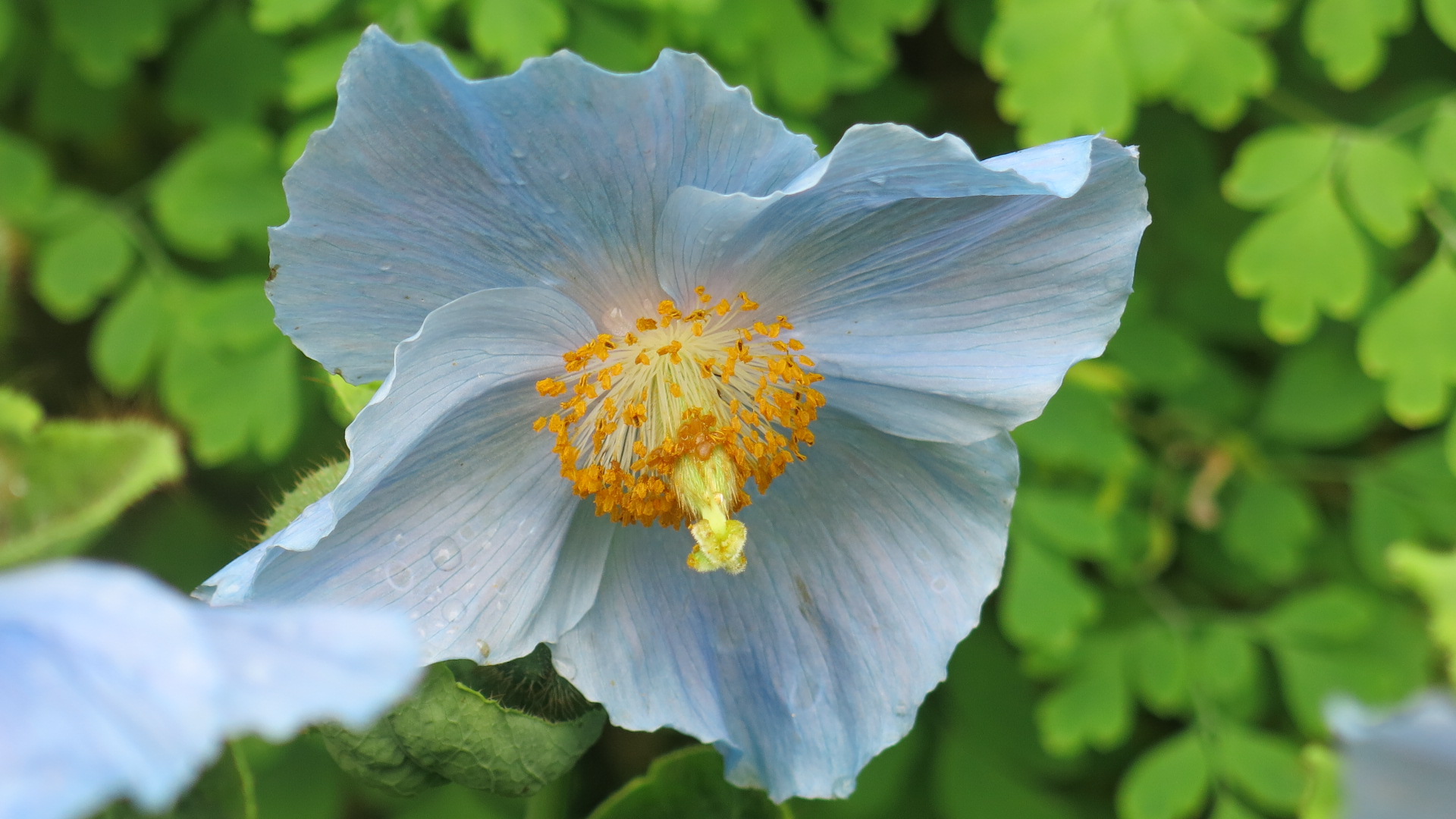 Meconopsis betonicifolia
Meconopsis betonicifoliaMertensia virginica, Virginia bluebells, Zones 3-8. Virginia bluebells are a delightful ephemeral spring perennial Wide glaucous leaves arise in spring and bear racemes of flowers that start out pink and turn blue. The flowers curiously have a slender tube at the top opening to a bell-like skirt at the bottom. If you have a shady area in your garden, or are developing a woodland garden, this is a must. Grow Virginia bluebells in shade to part shade in rich, moist, humusy soil. They will create a lovely colony over time.
If you have a chance, visit Winterthur for its woodland gardens in April. The Azalea Woods especially is carpeted in Virginia bluebells, Anemone apennina, Trillium grandiflorum (and other trilliums), wood hyacinths, Uvularia perfoliata, bleeding hearts, violets, epimediums, and more. An absolute delight!
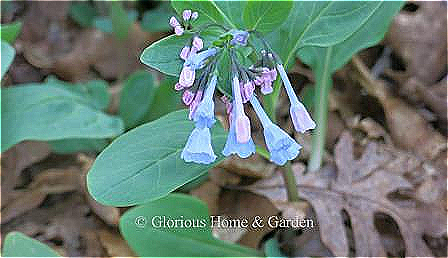 Mertensia virginica
Mertensia virginicaMyosotis sylvatica, woodland forget-me-not, Zones 5-9. Among spring perennials, forget-me-nots are among the most charming. The clear sky-blue flowers with tiny yellow eye are fresh and cheerful. They are great to amass, fill in gaps in the border and to allow spring bulbs to grow through where they will help to disguise the dying bulb foliage. Forget-me-nots are short-lived perennials that are best treated as biennials. They are easy to start from seed, and, in fact, once established will self-seed in the garden. Growing from 6-12" tall and wide, forget-me-nots prefer part shade and consistent moisture. Do not confuse Myosotis sylvatica, the woodland forget-me-not' with Myosotis semperflorens, the water forget-me-not, which is an invasive pest is parts of the country.
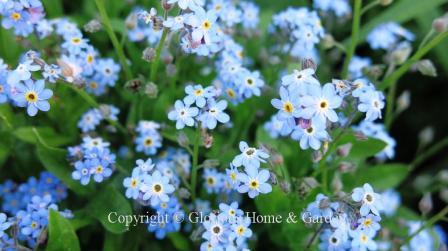 Myosotis sylvatica
Myosotis sylvaticaPeonies
Paeonia japonica, woodland peony, Zones 3-8. Flowers for a shady spring woodland garden? Absolutely! This herbaceous peony is little known, but will become a favorite in your garden. Preferring the sun of a deciduous forest before the leaves come out, these 1-1 1/2' tall spring perennials will self-seed Single white flowers are followed by attractive foliage all summer and even display red seeds in the fall before disappearing for the year.
Paeonia lactiflora, herbaceous peony, Zones 3-7. Surely the most luxurious blooms in the spring garden, peonies are lush and romantic, and have been the subject of culture and art for centuries. Long-lived and easy to care for, peonies do best with full sun, fertile soil, regular feeding (they are heavy feeders) and adequate moisture with good drainage to thrive. The heavy blooms, especially of the double cultivars, often require staking. Peonies need cold temperatures during their dormancy period, and some cultivars, especially the late-blooming and double ones, do best in northern climes. For the Southern garden, the single, semi-double and Japanese types and early to mid-season bloomers do best. One of the main causes of failure to bloom is planting too deeply. The eyes of the tubers should not be more than 2” below the soil surface. In southern areas, the eyes should be peeking through or just below the surface.
Plant peonies among
other perennials as part of a succession of bloom—the foliage is attractive
even when the plants are out of bloom.
Or consider planting them in a cutting garden or even the vegetable
garden if you plan to cut them for indoor arrangements. However you use them, do plan to include a
few peonies in your garden, and you will be rewarded with beauty for many years
to come. 'Bowl of Cream' is shown below. Click here for more gorgeous peonies!
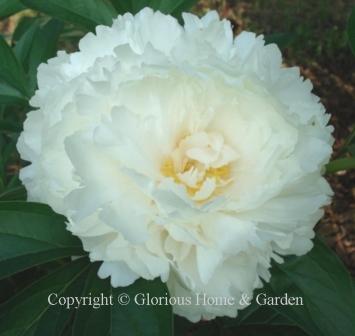 Paeonia lactiflora 'Bowl of Cream'
Paeonia lactiflora 'Bowl of Cream'Paeonia suffruticosa, Moutan or Chinese tree peony, Zones 4-7. Tree peonies are not actually trees, but woody stemmed shrubs that can grow to 4-5’. They are deciduous, but bloom on old wood, so are not pruned back in the fall. The foliage is more deeply cut than herbaceous peonies and the huge flowers come in gorgeous colors of white, pink, maroon, lavender, and purple. Long-lived, but slow growing, the spectacular display will increase every year. Tree peonies bloom after the woodland peonies, but before the herbaceous peonies.
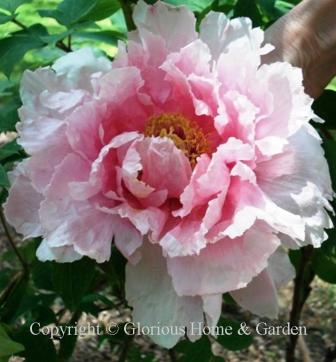 Paeonia suffruticosa 'Hanakisoi'
Paeonia suffruticosa 'Hanakisoi'Papaver orientale, Oriental poppy, Zones 2-7. The silken blooms and clear colors of Oriental poppies are must-haves in the spring garden. Blooming in late spring to early summer, poppies are great companions with alliums, Dutch iris, foxgloves and anemones. Colors of white, pink, salmon, yellow, orange and scarlet.
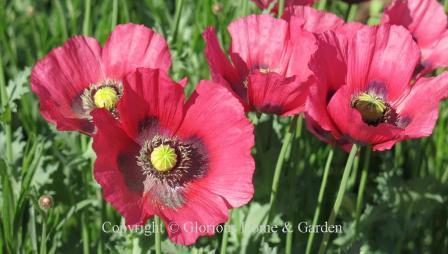 Papaver orientale
Papaver orientalePenstemon X 'Dark Towers,' hybrid penstemon or beard tongue, Zones 3-8. This is an attractive perennial for mid to back of the border growing 2-3' tall. It makes a nice foliage background with its dark leaves and red stems. The tubular flowers are pale pink and show off well against the foliage.
Phloxes
Few spring perennials beat the woodland and creeping phloxes for masses of color in partial shade. Low mounds of foliage are covered with blooms creating carpets of color. Lighter colors like white and pale blue will have more impact in shady locations.
Phlox divaricata, woodland phlox, Zones 3-8. Phlox divaricata is a North American woodland wildflower that has made itself at home in garden settings. Nice for a semi-shady location, woodland phlox is a good stoloniferous spreader, creating a lovely ground cover when it blooms in spring. It is nice to have some of the small narcissus or squills pop up through it, or as a companion to other springs perennials like bleeding hearts, trilliums, ferns, heucheras, tiarellas, and hellebores. I have found, however, that it is prone to powdery mildew. If this occurs, cut back the stems after flowering for a new flush of growth. Cultivars include ‘Blue Moon,’ violet blue; ‘Fuller’s White,’ white; ‘Charleston Pink,’ pink; 'Chattahoochee,' lilac-blue with purple eye; 'Clouds of Perfume,' pale blue; London Grove Blue,’ a rich lavender-blue; and ‘Louisiana,’ purple with a deeper eye.
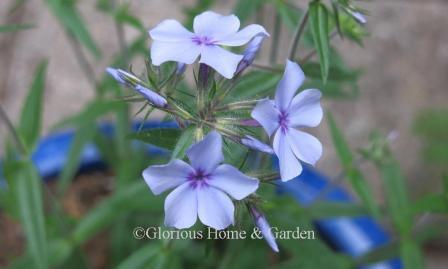 Phlox divaricata subsp. laphamii 'Chattahoochee'
Phlox divaricata subsp. laphamii 'Chattahoochee'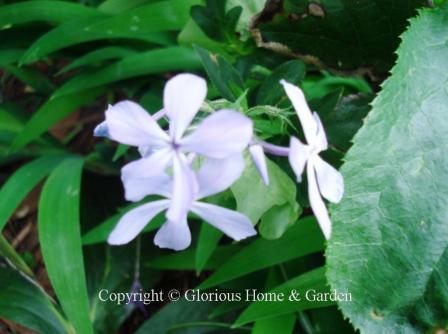 Phlox divaricata 'Clouds of Perfume'
Phlox divaricata 'Clouds of Perfume'Phlox stolonifera, creeping phlox, Zones 2-8. Creeping phlox, like woodland phlox, spreads via stoloniferous rhizomes and forms a low, dense mat. A North American native like Phlox divaricata, it prefers evenly moist, humusy soil, and tolerates shade well, but flowers best in partial shade. It is slightly shorter in bloom at 6-12” than woodland phlox. But it is also susceptible to powdery mildew in humid conditions. Flower colors are similar to P. divaricata and include ‘Bruce’s White,’ white; ‘Home Fires’ pink; 'Sherwood Purple,' violet-blue ; and ‘Variegata,’ with variegated leaves and pink flowers.
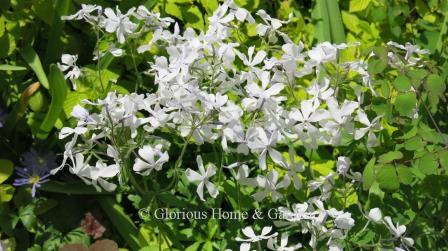 Phlox stolonifera 'Bruce's White'
Phlox stolonifera 'Bruce's White'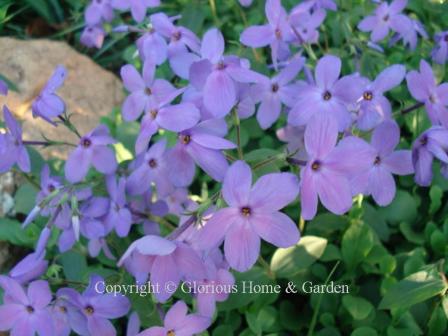 Phlox stolonifera 'Sherwood Purple'
Phlox stolonifera 'Sherwood Purple'Phlox subulata, cushion or moss phlox, Zones 2-8. Moss phlox, or « thrift » as it is commonly called, is a good choice for full sun. It can provide large swathes of color in the spring, but a common mistake is to plant it in islands of isolation. Use it in groups, or drifts definitely, but in combination with bulbs, shrubs and other spring perennials. There are many cultivars available in shades of white, pink, rose, red, purple, blue, and striped. ‘Emerald Cushion Blue’ is shown.
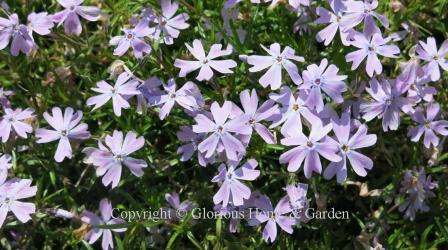 Phlox subulata 'Emerald Cushion Blue'
Phlox subulata 'Emerald Cushion Blue'Polygonatum odoratum 'Variegatum,' variegated fragrant Solomon's
seal, Zones 3-8. This is one of the most
striking spring perennials for the woodland garden. The leaves are edged in creamy white enhanced
by reddish stems and bearing pairs of white flowers under the leaves. They will increase to form colonies. Very effective in groups with bulbs, ferns,
hostas, bleeding hearts, trilliums and other shade lovers of the spring
woodland.
Perennial Plant
Association’s 2013 Perennial Plant of the Year.
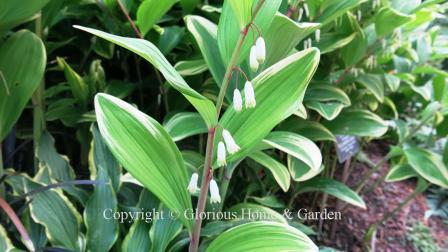 Polygonatum odoratum 'Variegatum'
Polygonatum odoratum 'Variegatum'Primroses
Primula auricula, auricula primrose or bear’s ear, Zones 3-7. Originating in the alpine climate of Europe, primroses don’t do well in the heat and humidity of the South. As beautiful as they are, they don’t last long in my 7b garden. So if I want a few primroses in the spring, I have to treat them as annuals. But where they are better suited, these evergreen perennials are much prized. A basal rosette of evergreen leaves said to resemble a bear’s ear (auricula also means ear-shaped), are topped with a cluster of yellow flowers in the species. Many cultivars have been developed in striking color combinations. The British are especially keen on primroses. An interesting site for more information is www.auriculaandprimula.org.uk.
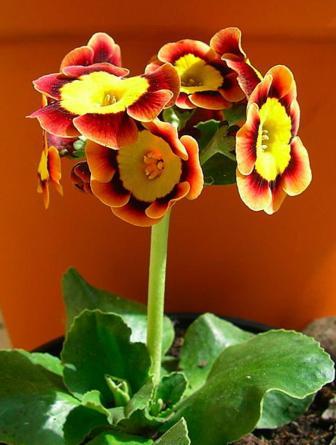 Primula auricula (public domain)
Primula auricula (public domain)Primula japonica, Japanese or candelabra primrose, Zones 5-7. Japanese primroses are can be grown successfully in the South as long as they are provided with a consistently moist environment as along a pond or stream bank, soil rich in organic matter and partial shade. With their fresh green leaves and soft colors of white, pink, rose, red and purple, these plants will make a gorgeous display. 'Postford White' is shown.
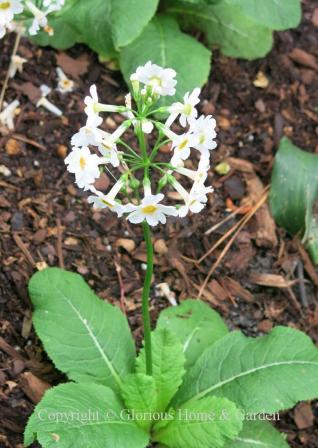 Primula japonica 'Postford White'
Primula japonica 'Postford White'Primula x polyantha, polyantha primrose, Zones 3-8. Polyantha primroses are low, compact hybrids developed from several different species. They are densely covered with blooms in spring and come in a wide variety of colors including white, pink, red, yellow, blue, and violet. Great to use as bedding plants and in containers. They do their best in areas with cool, moist conditions.
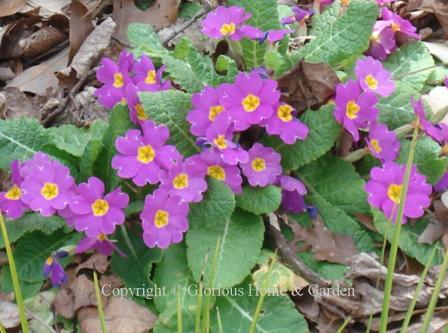 Primula x polyantha
Primula x polyanthaPrimula veris, cowslip, Zones 2-9. This is the common primrose of European meadows and fields. An 8” spike with bright yellow tubular flowers arises from a base of heavily-veined puckered leaves.
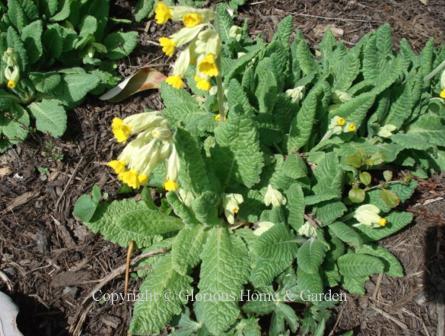 Primula veris
Primula verisPrimula vulgaris, English primrose, Zones 5-8. Small soft yellow flowers with a darker eye arise about 6-8” from a clump of fresh green leaves in spring. Lovely in company with spring trilliums, violets, bleeding hearts, and Virginia bluebells. Loves good humus-y soil, consistent moisture and partial shade.
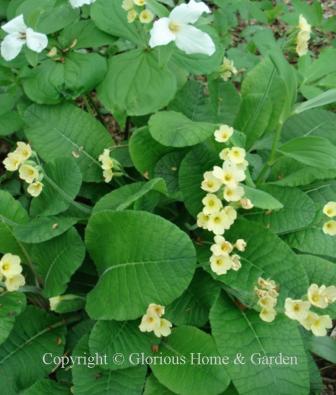 Primula vulgaris
Primula vulgaris
Pulmonaria longifolia, long-leafed lungwort, Zones 3-8. As the common name says, this lungwort has long, narrow spotted leaves. Interestingly, the name “lungwort” supposedly refers to the resemblance of the leaves to diseased lungs—now who came up with that? Probably an herbalist monk in a monastery. The flower open pink and mature to violet-blue as they mature, rather like Virginia bluebells (Mertensia), which happen to be in the same family. ‘Roy Davidson,’ below, is a hybrid between P. longifolia and P. saccharata and has light blue flowers. ‘Trevi Fountain’ is another hybrid with beautiful silvery spotted leaves and a long bloom period beginning at the end of February in my Zone 7b garden, and continuing until the end of April. Great for a shade garden and to use with small spring bulbs like grape hyacinths, miniature daffodils, and Scilla siberica.
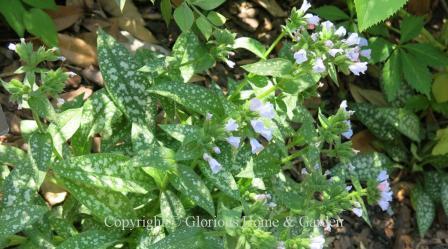 Pulmonaria x 'Roy Davidson'
Pulmonaria x 'Roy Davidson'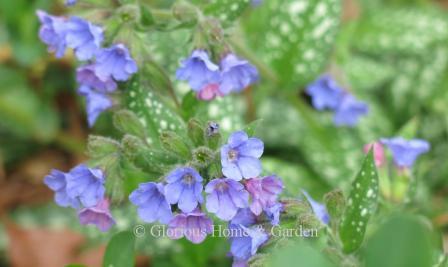 Pulmonaira x 'Trevi Fountain'
Pulmonaira x 'Trevi Fountain'Pulmonaria saccharata, Bethlehem sage, Zones 3-7. The dark green leaves of this lungwort have even spottier leaves than the above species. The species name reflects the sugar-sprinkled appearance of the leaves. Some cultivars are so spotted as to be almost entirely silver such as ‘Mrs. Moon.’ Other cultivars include ‘Raspberry Splash’ with raspberry pink flowers fading to blue; ‘White Wings' has pink buds opening to white flowers. Pulmonarias, with their striking foliage, make a beautiful edging or ground cover in company with other fine spring perennials like ferns, Virginia bluebells, early bulbs, and bleeding hearts in a shady location with good moisture.
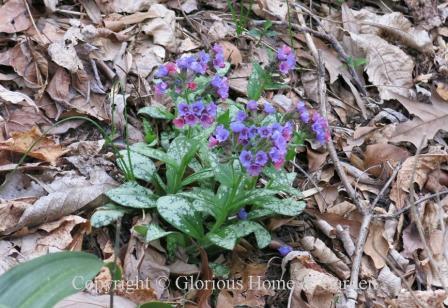 Pulmonaria saccharata
Pulmonaria saccharataSaxifraga stolonifera, strawberry begonia, strawberry geranium, mother-of-thousands, Zones 7-9. This is one of my favorite spring perennials for a ground cover in a partially shaded situation. Because the plant spreads by thin runners that root where they touch the ground, it makes a nice clump fairly quickly. Loose panicles of white flowers rise above the foliage about 12”, creating a charming, airy effect dancing in the breeze. Even out of bloom, the evergreen foliage is attractive with its rounded leaves with silver veining and reddish undersides. The common names refer to the resemblance of the leaves to begonias or geraniums and the strawberry-like runners that produce many new plantlets—thus “mother-of-thousands.”
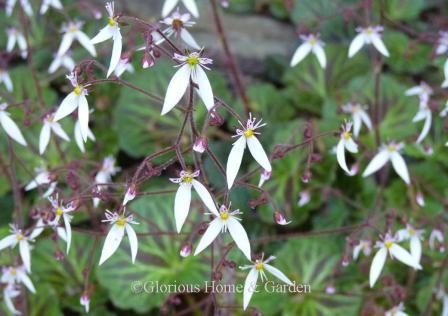 Saxifraga stolonifera 'Fred Galle'
Saxifraga stolonifera 'Fred Galle'Scabiosa caucasica, scabious or pincushion flower, Zones 3-7. I love the airy appearance of scabiosa blooms waving in the breeze, it’s a pretty effect, but I admit that I have had difficulty keeping them alive for long. I think they like cooler conditions than the heat and humidity of the South, but I keep trying nevertheless.
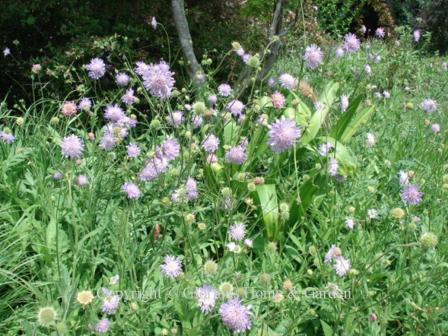 Scabiosa caucasica
Scabiosa caucasicaSilene flos-cuculi, see Lychnis flos-cuculi.
Spigelia marilandica, pinkroot or Indian pink, Zones 6-9. What a charming standout for the late spring to early summer garden! Native to the southeastern U.S., pinkroot has striking red tubular flowers lined with yellow that flare out from the top like little golden stars. Great for a partly-shaded woodland border or native plant garden, and great for attracting butterflies and hummingbirds. Partial shade to shade is ideal, but will grow in sun also with humus-rich soil and consistent moisture.
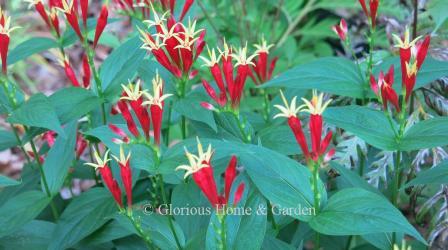 Spigelia marilandica
Spigelia marilandicaStachys byzantina, lamb's ears, Zones 4-7. Lamb’s ears make a delightful ground cover in the perennial border with their soft, fuzzy leaves—and children love to touch them. The gray-green foliage is a good foil to combine with other colors in the garden. Spikes of purple flowers occur in spring, but the main attraction is the leaves. Grow in full sun or partial shade with good drainage. ’Countess Helene von Stein,’ which has larger leaves than the species, is pictured.
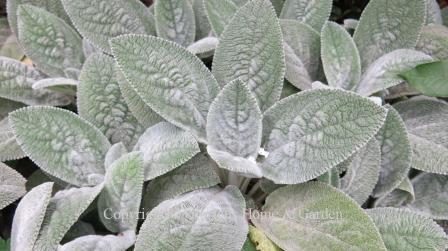 Stachys byzantina 'Helene von Stein'
Stachys byzantina 'Helene von Stein'Thalictrum aquilegifolium, columbine meadow rue, Zones 5-7. This tall (up to 3’), airy late spring perennial is excellent for the back of the border. In shades of white, lavender, pink, or purple, each individual bloom resembles a miniature fireworks explosion. Actually petal-less, the color comes from the sepals, stamens and flower stalks rising above ferny, columbine-like blue-green foliage. The cumulative effect is showy and delicate. Prefers semi-shade and rich soil with consistent moisture.
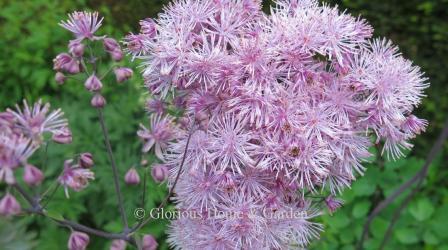 Thalictrum aquilegifolium
Thalictrum aquilegifoliumTiarella cordifolia, Allegheny foamflower, Zones 3-8. An Eastern North American native, our woodland foamflower is a lovely spring perennial that prefers shade and rich soil amended with organic matter and regular moisture to thrive. The species has heart-shaped leaves with purple-ish veining and is semi-evergreen. Short stalks arise above the leaves and produce a bottlebrush of tiny white flowers opening from the bottom up and usually pink at the tip. The plants spread by stolons to form colonies. Many cultivars have been developed with leaf-shape ranging from the lobed heart shape of the species to deeply incised leaves often with a dark contrasting veining. Larger, showier inflorescences have been produced as well with some emphasizing the pink coloration such as ‘Pink Brushes’ and ‘Pink Skyrocket.’ Beautiful leaf colorations are evident in cultivars like ‘Elizabeth Oliver’ and ‘Running Tapestry.’ Crosses between T. cordifolia and Heuchera americana create the hybrids known as heucherella.
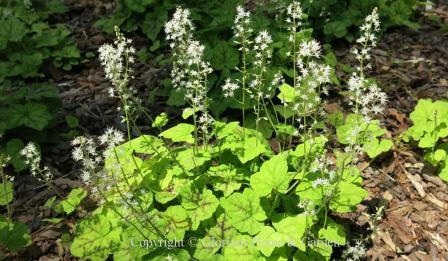 Tiarella cordifolia 'Running Tapestry'
Tiarella cordifolia 'Running Tapestry'Tradescantia virginiana, Virginia spiderwort or dayflower, Zones 4-9. This North American native is a great plant for a natural woodland garden in partial shade to sunny locations. It grows about18-36” tall with blue-violet flowers. Each individual flower lasts for only a day hence the other common name of dayflower, but the plant continues to bloom over a long period from spring to early summer, though I've found that the species will keep going until frost stops it. After blooming, the foliage may decline, and some varieties develop unsightly leaf spotting due to fungal infections. Cutting the plants off at the base and discarding the infected leaves can help and will encourage a fresh flush of growth in late summer—and maybe some repeat blooming. Many cultivars have been developed including ‘Concord Grape’ with purple flowers; ‘Snowcap’ with white flowers; 'Sweet Kate' (also known as ‘Blue and Gold’) with chartreuse leaves and contrasting purple flowers; and ‘Zwanenburg Blue’ with purple-blue flowers. The Chicago Botanic Garden did a study of T. virginiana cultivars to discover which ones were the most susceptible to leaf spotting and they found that those with moderate susceptibility include ‘Blue and Gold’ (‘Sweet Kate’), ‘Innocence,’ and ‘Snowcap.’ Some with low susceptibility include ‘Angel Eyes,’ ‘Concord Grape,’ ‘Purple Profusion,’ ‘Therese,’ and ‘Zwanenburg Blue.’ ‘Little Doll’’Sylvana,’ and ‘White Doll’ were said to have severe susceptibility.
 Tradescantia virginiana
Tradescantia virginiana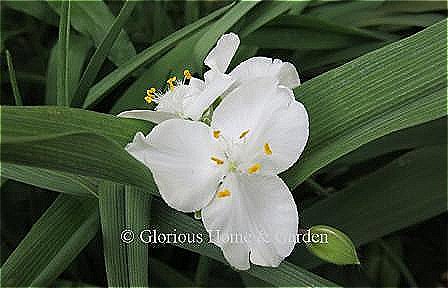 Tradescantia x andersoniana 'Snowcap'
Tradescantia x andersoniana 'Snowcap'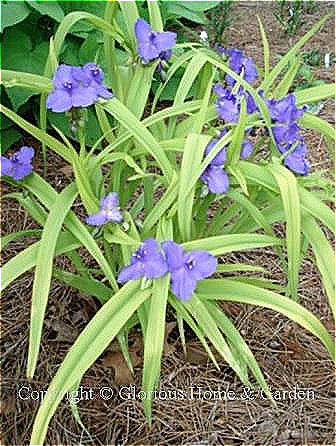 Tradescantia x andersoniana 'Sweet Kate'
Tradescantia x andersoniana 'Sweet Kate'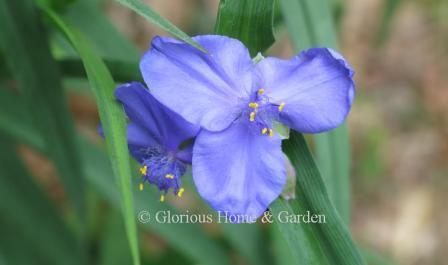 Tradescantia x andersoniana 'Zwanenburg Blue'
Tradescantia x andersoniana 'Zwanenburg Blue'Veronica umbrosa, speedwell
'Georgia Blue,' Zones 6-8. One of my
favorite ground covers, and spring perennials in general, is 'Georgia Blue' veronica (named for the Georgia of the
Caucasus region of Asia where it was found) for its low mat of dark green
glossy foliage and beautiful tiny blue flowers.
It begins flowering very early in late winter and continues through
mid-spring. Lovely with small spring
bulbs and daffodils.
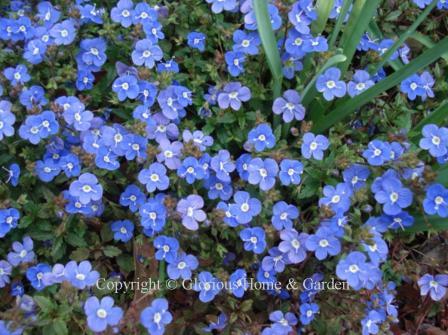 Veronica umbrosa 'Georgia Blue'
Veronica umbrosa 'Georgia Blue'Violets
Viola labradorica, Labrador violet, Zones 3-8. I understand that the botanical name of this species as recently been changed to Viola riviniana 'Purpurea,' but whatever it is called, this is a charming spring perennial to grow among small bulbs like puschkinias, squills, or snowdrops. Its purple leaves and violet flowers spread by rhizomes and self-seeding to make a nice ground cover for a shady area, but I’m annoyed that the deer find it a tasty nibble.
 Viola labradorica
Viola labradoricaViola odorata, sweet or English violet, Zones 6-8. This low-growing spring perennial is evergreen and a true violet in color. The sweet fragrance is ephemeral, but delightful. Sweet violets form clumps of heart-shaped leaves and are most at home in a shaded woodland setting with humus-rich moist soil. Quite a few cultivars are available in shades of white, pink, blue, purple and violet. Among them are ‘Blue Remington,’ blue; ‘Columbine,’ blue with a large white eye; ‘Dick o’ the Hills,’ white tinged with pink; ‘Rosina,’ pink; and ‘Royal Robe,’ deep violet.
Return to Spring Perennials A-D
Return to Spring Perennials E-L
Plant of the Month
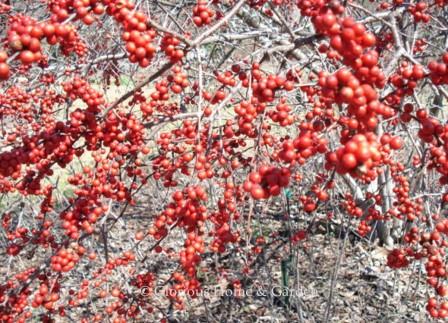
Ilex verticillata
Winterberry holly
Updated new USDA Plant Hardiness Zone Map 2023.